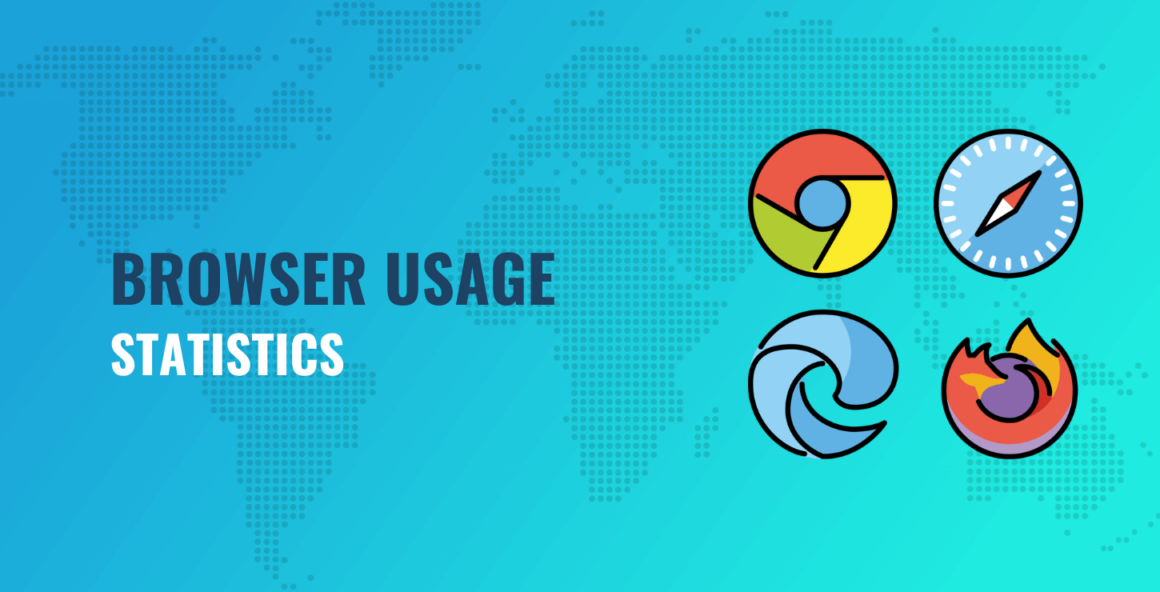Web browsers act as the software portal through which you and I can connect to the internet and seamlessly request or receive information.
Let’s delve into up-to-date browser usage statistics to uncover trends in market share, device-specific usage, and regional and country-level preferences. 🧭
Key Takeaways
- Estimates suggest there are nearly 200 browsers in existence.
- Five major web browsers dominate the market, accounting for 98.3% of the market share.
- In January 2009, 65% of users preferred Internet Explorer, while in January 2023, the same percentage chose Google Chrome.
- Google Chrome maintains its status as the most used browser across various devices.
- Safari enjoys a higher market share in regions with a higher GDP per capita.
Browser Market Share Worldwide ✈️
We may not know the exact number of browsers in existence in the world today (due to many factors that affect how browsers are counted and measured), although some estimates put the number close to 200 in 2023 [1].
But we know for sure that only five web browsers dominate the market, accounting for 98.3% of the market share. Among these popular portals to the internet, Google Chrome is the undisputed leader, claiming 58.96% of the global browser market share for all platforms. Safari (28.13%) takes second place, followed by Edge (5.9%), Firefox (2.7%), and Samsung Internet (2.61%) [2].
Browser Market Share by Year 📅
Interestingly, this picture of the most used browsers has been almost unchanged for the past five years, and some formerly popular browsers have dropped off the chart entirely. For example, nearly 65% of internet users across all platforms used Internet Explorer (IE) in January 2009. However, it was dethroned by Google Chrome in 2012, and the picture has remained almost static over the past five years [3].
The only competition seems to occur among the browsers from third place and beyond. For example, Microsoft Edge, Internet Explorer’s successor, has managed to gain against former mainstays like Firefox to cement its place among the top three browsers. Others, like Opera and UC Browser, seem to be dropping off in the same manner as IE.
Browser Market Share by Device Type 💻
🤩 Fun fact: more than half of internet traffic in November 2023 came from mobile devices (63.64%). Desktop traffic accounted for 34.95% of global traffic share and 1.41% for tablets [4].
Mobile browser market share
Because mobile devices are responsible for most of the global internet traffic today, it follows that browsers that rule this platform enjoy the most usage worldwide [5].
Google Chrome retains the lead regarding web browser usage on mobile platforms (64.52%) as of November 2023. Safari is second, with a 25.19% market share, and Samsung Internet (4.58%) closes the top three list.
Other browsers with notable usage on mobile platforms include Opera (2.1%), UC Browser (1.45%) and Firefox (0.51%).
Desktop browser market share
Desktops once ruled the internet traffic space, but that was many years ago. But while mobile platforms have given relevance to little-known browsers, the veterans dominate the desktop world, the only constant being Google Chrome [6].
As of November 2023, 61.94% of all desktop internet traffic happened via Google Chrome. Safari took second place (13.44%), and Edge closed the top three selections (11.19%). Firefox, which once ruled this niche, accounted for a measly 6.66% of the market share, and Opera was the fifth most used, with a 4.59% market share [7].
Tablet browser market share
Browser usage in the tablet landscape is a replica of the mobile platform. Google Chrome claims a 50.42% market share, followed by Safari (34.69%), Android (12.4%), Opera (0.88%), Edge (0.58%), and Yandex (also called YaBrowser) (0.26%) [8].
Web Browser Usage by Region & Country 🗺️
Google Chrome is favored across all regions, with a global average of 62.85%. However, it is clear that North Americans are more open to Chrome alternatives, which happens to be Safari (31.07%) [3]. This could be due to the dominance of the iPhone as the most widely used mobile phone brand in the region, which has Safari as the default browser [8].
Chrome and most used web browsers on desktop platforms are more prevalent in Africa and Asia; Chrome (73.61% in Africa and 71.96% in Asia) and Edge (2.66% in Africa and 3.18% in Asia). However, it is clear that Safari has a larger share of the browser market in regions with higher GDP per capita, probably because more people here can afford iPhones and MacBooks.
…
Don’t forget to join our crash course on speeding up your WordPress site. Learn more below:
Was this article helpful?
No
Thanks for your feedback!

Or start the conversation in our Facebook group for WordPress professionals. Find answers, share tips, and get help from other WordPress experts. Join now (it’s free)!
Keep reading the article at CodeinWP. The article was originally written by Ruchi Gupta on 2024-02-08 07:00:00.
The article was hand-picked and curated for you by the Editorial Team of WP Archives.
